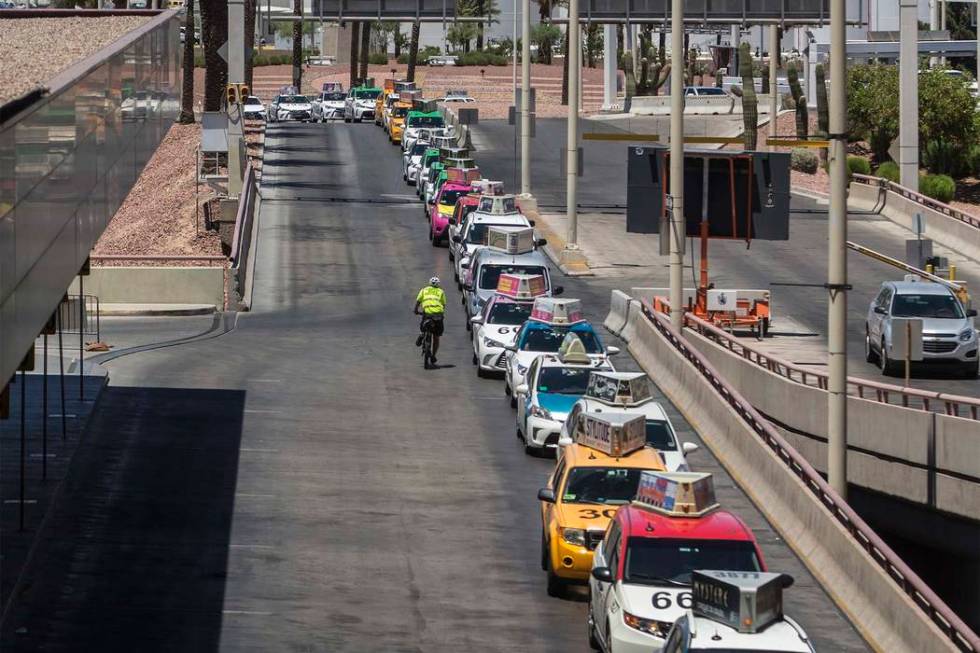Kaptyn hopes to steer Las Vegas taxi industry toward the future

Kaptyn Inc.’s pending deal to acquire a pair of Las Vegas transportation groups is about evolving the longstanding cab companies to better compete with emerging technologies.
The mobility technology company filed Monday to acquire Desert Cab Co. and ODS Chauffeured Transportation, owned by the Balaban family, and Whittlesea-Bell Transportation, owned by the Bell family and comprised of Whittlesea Blue Cab, Henderson Taxi, Bell Limousine, Bell Trans and Presidential Limousine. The two groups also jointly own Virgin Valley Cab, which they purchased from Frias Transportation earlier this year.
The groups Kaptyn seeks to acquire account for 872 of the 3,250 cabs in Las Vegas, along with private vehicles and limousines.
The Bell family has been involved in the taxi industry in Nevada since the 1940s, while the Balabans have been involved since the 1970s. That legacy is a key aspect to the deal, according to Kaptyn CEO Andrew Meyers.
Kaptyn began working with Bell and Balaban five years ago, and as their relationship evolved, Kaptyn’s interest in the market grew, Meyers said.
He said Kaptyn wants “to help efficiencies and (bring) innovation to the taxi class, which we thought was very antiquated at the time.”
The state Taxicab and Transportation authorities still need to approve the acquisition. If the deal is approved, Whittlesea-Bell President Brent Bell and Desert Cab President George Balaban will stay on in senior level roles.
Bell will serve as senior vice president of luxury operations under the Kaptyn name, while Balaban will serve as senior vice president of taxicab operations. The Bell and Balaban families will retain minority ownership in the deal.
“I will oversee the luxury operations along with government affairs,” Bell said. “My management team for the most part will stay intact. If you take our management experience, along with Kaptyn and the technology they’re going to bring to the table, I’m really excited about the things we’re going to do in the future.”
Bell said high rollers in Las Vegas still value limousines and luxury car service, and he believes Kaptyn will help bring those services to new heights.
“There’s no question that the limo and black car service has been affected by rideshare as well,” Bell said. “We believe with Kaptyn’s resources and their technology, that we’re going to ramp that service back where it was and it’s going to be successful for us.”
Kaptyn’s move into a larger role in the Las Vegas taxi scene infuses new capital and new ideas into the space that’s seen yearly ridership drops ever since Uber and Lyft began operating in 2015.
Kaptyn officials studied the market in the Las Vegas Valley, including what the ride hailing companies are doing with their mobile apps, their customer relations and various staging lots they utilize, to conjure up ideas of how to improve the taxi product.
“What strategies, resources or partnerships could be implemented to turn that (ridership dip) around?” Meyers said. “That’s the evolution of Kaptyn Inc. the software company and… then the entire Bell and Balaban organizations and assets.”
The new plans for the company will be rolled out over the next year and will be based on four key pillars.
Ridership experience: The driver/rider experience is key as creating a consistent level of service is important to landing new customers and creating return customers. The cost of the trip plays into this, Meyers said.
The company also plans to invest in the drivers and will make upgrades to Bell’s existing headquarters, including cosmetic improvements, technology improvements, adding employee lounge/gym and more.
Bridging the gap with ride hailing companies: Over the next two years Kaptyn plans to roll out an approach “where you can start to marrying the positives on both sides from ride sharing and traditional fleet structure,” Meyers said. He believes that could catch on as the model other cities look to when trying to close the gap between taxi and ride sharing services.
Brand: Kaptyn is moving away from the taxicab or limousine specific fleet names to just a mobility fleet. That would create a large brand that consumers would know and lead them to think of hailing a taxi or limo as no different from getting an Uber or Lyft ride.
Reducing carbon footprint: Kaptyn will look to increase the use of eco-friendly vehicles in its fleet and utilize emerging vehicle technology. The strategic goals will be phased into the market over time, as different approvals and regulatory hurdles are cleared, Meyers said.
“The overall mobility market is evolving, with ride sharing, electrification, autonomy, as we’re seeing here in Vegas,” he said. “We’re going to continue to invest in the move from internal combustion vehicles to eco-friendly vehicles and ultimately fully electric vehicles. We believe that movement not only creates lower emissions for the community, but it also creates a value in that driver/rider experience.”
Contact Mick Akers at makers@reviewjournal.com or 702-387-2920. Follow @mickakers on Twitter.